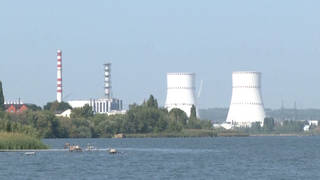
Guests
- Olexi Pasyukdeputy director of Ecoaction, a Ukrainian environmental organization, where his focus is on energy and nuclear energy.
Links
Evacuation efforts are underway in southern Ukraine, where floodwaters are rising after a dam on the Dnipro River was breached overnight in the Ukrainian city of Nova Kakhovka. The breach has created an additional humanitarian disaster in an area that’s seen heavy fighting since Russia’s invasion. Ukraine’s government says floodwaters are threatening 80 towns and villages, as well as the city of Kherson, home to 300,000 people. The breach could also limit drinking water supplies across Kherson and Crimea. Ukrainian officials accused Russia’s military of deliberately sabotaging the dam, calling it an act of “ecocide,” while Russian officials blamed Ukrainian artillery fire for the breach. The disaster has raised fears of a nuclear accident at Europe’s largest nuclear power station, the six-reactor Zaporizhzhia plant, which is upstream of the dam breach and relies on a reservoir formed by the dam for critical cooling systems. We go to Kyiv to speak with Olexi Pasyuk, deputy director of the Ukrainian NGO Ecoaction, to discuss the environmental implications.
Transcript
AMY GOODMAN: This is Democracy Now!, democracynow.org, The War and Peace Report. I’m Amy Goodman, with Juan González.
Evacuation efforts are underway in southern Ukraine after an explosion destroyed a critical dam on the Dnipro River in the Russian-occupied region of Kherson. Ukraine and Russia are blaming each other for the blast. Ukraine’s government says floodwaters are threatening 80 towns and villages, as well as the city of Kherson, home to over 300,000 people. The breach could also limit drinking water supplies across Kherson and Crimea.
The disaster has raised fears of a nuclear accident at Europe’s largest nuclear power station, the six-reactor Zaporizhzhia plant, which is upstream from the dam. Russian officials say the water levels of a reservoir used to hold cooling water for the plant has already fallen by more than eight feet. The International Atomic Energy Agency said there is no, quote, “immediate nuclear safety risk.” Ukraine also says at least 150 tons of machine oil has been released into the Dnipro River.
Ukraine’s Ambassador-at-Large Anton Korynevych spoke earlier today at the International Court of Justice in The Hague.
ANTON KORYNEVYCH: Under the leadership of President Zelensky and with the courage of the Armed Forces of Ukraine, Russia cannot defeat us on the battlefield, so it targets civilian infrastructure to try to freeze us into submission. Earlier today, just today, just Russia blew up a major dam located in Nova Kakhovka, causing significant civilians’ evacuations, harsh ecological damages, and threatening the safety of the Zaporizhzhia nuclear power plant. Russia’s actions are the actions of a terrorist state and aggressor.
AMY GOODMAN: Meanwhile, the Russian-installed governor of the Kherson region, Vladimir Saldo, blamed Ukraine for the attack on the dam.
GOV. VLADIMIR SALDO: [translated] The reason for this behavior is simple. There is a saying in Ukraine: If I cannot eat something, I will at least bite it — meaning, if we are unable to do something properly, we will play dirty tricks. And first of all, it is about creating a humanitarian crisis with food shortages. But you know what? We will never starve, because the whole of Russia is with us now. Another reason is to deflect attention from the horrible defeats that Ukraine faced during their counteroffensive yesterday.
AMY GOODMAN: We go now to Kyiv, the capital of Ukraine, where we’re joined by Olexi Pasyuk, deputy director of the Ukrainian NGO Ecoaction, where his focus is on energy and nuclear energy.
Olexi, thanks so much for being with us. It is not clear what happened at this point. What is clear is that there is major flooding and that there is the largest nuclear power plant in Europe located in Ukraine. The question is, among other things: Is that threatened? Can you talk about what you understand at this point and what you’re most concerned about?
OLEXI PASYUK: Yeah, well, I will start that it’s pretty clear what happened. It’s not very clear what are the consequences. But I find it that you give to much space to Russian explanation what is happening. It was reported already last year that Russians have prepared to mine, basically, the dam, because it was one of the scenario what you do. And there is a clear situation now with Ukraine kind of planning to start a military operation to kick off Russians from the left bank of Dnipro River. And one of the options which was on the table which was discussed is Ukrainians crossing the river. So, it’s a kind of obvious military solution to flood the area at this moment.
Now, as to the impact, obviously, the territory is flooded. And as with any similar, I mean, flooding, and especially of this scale, you have an impact which can be caused by, like, facilities which are on the ground, which consider oily materials — I don’t know — waste storages. All that is basically now flooded, although they were not designed to withstand it. Exactly as it was mentioned, there is an issue of immediate impact of flooding now, but then the reservoir is also a source of water, and there will be a major impact later through the year and the summer for the areas which use this water for agriculture, basically.
Now, the reservoir, indeed, over the dam, is a source of water, and that’s where Zaporizhzhia nuclear power plant stays. But we have to understand that there was part of this area which is separated by the dam, so, effectively, nuclear power plant has part of the reservoir, which will not be immediately impacted by the falling water level, because it’s a separated water pool. And also, we have to recall that currently five or six units are in so-called cold shutdown, so they don’t produce electricity, and so the demand for cooling is lower. However, they have one unit operational just to maintain electricity for supply for their own needs. So, there is — as International Atomic Energy Agency said, there is no immediate threat, because now they still have water and electricity. But the question is for how long they will be able to maintain it.
So, we face a future risk that our plant would not have enough water to cool down. And it’s not — there is no obvious solution at this moment to understand how it will be solved. They would need to provide water at certain moment. We don’t know how much water will stay, in the sense that we don’t realize yet how big is damage to the dam, if there will some water stay in the reservoir. And, of course, while technically there are possibility of solutions, it’s all happening in the combat areas. So it’s very difficult to repair. It’s difficult, for example, to make evacuation at this moment, because the Russians are basically shooting into the areas where evacuation is happening. And also there are these unexpected for normal life impacts, like you have some areas which were mined, and so now you have this mine basically taking over by water to the areas where they’re not supposed to be. So, this is obviously a disaster in very different senses.
JUAN GONZÁLEZ: And, Olexi, you mentioned that five of the six reactors have already been shut down, though they still need to be cooled to some degree. What are the prospects for that last reactor to be shut down? And why hasn’t it happened so far?
OLEXI PASYUK: Well, this is, I guess, a difficult choice now for people who maintain it, because the power plant for cooling, they need to have electricity. And you have to have external supply to the power plant, but we regularly saw this news when these lines were down so there was no electricity. So, they maintain — so, for cooling, you need water, and you need electricity to pump it. So, once you stop this reactor, you also have higher risk that you would not be able to pump water even if you have it. I guess this is a dilemma which a power plant station currently faces.
AMY GOODMAN: And, Olexi Pasyuk, who would this benefit the most? Russia says this will hurt more the Russian side, and that is more proof, they say, that Ukraine did this. But then you have the Ukraine counteroffensive that is said would be thwarted by this kind of catastrophe. Can you talk about the situation and where we’re actually talking about, how critical this area is at this point in the Ukraine war?
OLEXI PASYUK: Well, I think Russians and this guy who you previously showing, who is the occupation administration, had, he have difficult time to explain to the citizens why Russia, which is supposed to save them, flood them. For Ukrainians, there is no reason to doubt. That’s Ukrainian citizens, basically. We are eager the country to get them back.
Again, there is an expectation of the military advance by Ukrainian side. And when you were saying the dam is in the occupied territory, the dam is on the river, which currently separate two sides. So, Ukraine is planning offensive, and they were also planning to go across the river to the Russian-controlled areas. And flooding, in this sense, is effective. I assume it was blown up at this moment because Russians assumed that Ukrainians are ready to start moving forward in that area.
JUAN GONZÁLEZ: And, Olexi, we only have about a minute left, but I was wondering your sense of the counteroffensive that Ukraine has been supposedly launching in the last couple of days. What you’re hearing in Kyiv about it?
OLEXI PASYUK: Well, I don’t follow this military part, but I think it’s long expected. And I think the main message which we currently hear from the state is to be quiet about it, because if — so, there is very little information. And I think whoever could have it would not share it.
AMY GOODMAN: Well, Olexi Pasyuk, we want to thank you for being with us, deputy director of the Ukrainian NGO Ecoaction, where his focus is on energy and nuclear energy, joining us from the capital of Ukraine, Kyiv.
And that does it for our show. Following up on our previous discussion on Julian Assange, to see our interviews with Julian Assange when he was in the Ecuadorian Embassy taking refuge and, before that, when he was free, go to democracynow.org.
Democracy Now! is produced with Renée Feltz, Mike Burke, Deena Guzder, Messiah Rhodes, Nermeen Shaikh, María Taracena, Tami Woronoff, Charina Nadura, Sam Alcoff, Tey-Marie Astudillo, John Hamilton, Robby Karran, Hany Massoud and Sonyi Lopez. Our executive director is Julie Crosby. Special thanks to Becca Staley, Jon Randolph, Paul Powell, Mike Di Filippo, Miguel Nogueira, Hugh Gran, Denis Moynihan, David Prude and Dennis McCormick.
If you’d like to sign up for our daily digest, go to democracynow.org. I’m Amy Goodman in New York, with Juan González in Chicago. Our website is democracynow.org. Thanks for joining us.













Media Options